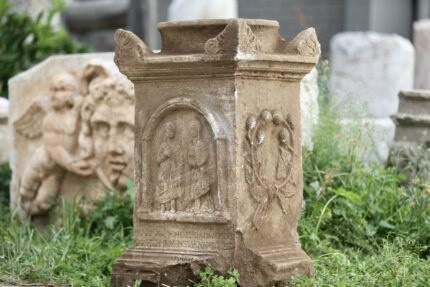Well-preserved Roman statue discovered in Varna – History

A well-preserved Roman portrait statue has been discovered in the Bulgarian Black Sea resort of Varna. The statue dates to the late 2nd or early 3rd century AD and, despite its age, suffered only minor damage: the right hand is missing and there are some scuffs on the face.
The statue was discovered during construction outside the ancient city’s defensive walls, in an area where a river once flowed in ancient times. It was lying in a thick pile of sand when construction crews exposed it. The contractor immediately informed the Varna Regional Historical Museum of the discovery, and archaeologists found the statue.
The sculpture is larger than life size and made of high quality white marble. It depicts an adult man with a short beard and neat robes. He holds a scroll in his left hand. The statue stands on a pedestal with Greek inscriptions. Initial translations of the inscription suggested that the man described was one G(aius) Marius Hermogenes, but inscription experts are now working to fully decipher and study the text.
The ancient city of Odessos (present-day Varna) was founded in the 6th century BC by colonists from the Greek city of Miletus. They built the city on the site of an earlier Thracian settlement dating back to the Late Bronze Age (13th to 12th century BC). It prospered thanks to its location on the Black Sea and its proximity to gold and copper mines. Around the time the sculpture was made, the prosperity of the Roman Empire reached its peak.
 The robes and scrolls indicate that Gaius Marius Hermogenes was a prominent citizen, perhaps a magistrate, who could afford an expensive marble portrait. It is almost certain that the old river bed outside the city walls where it was found was not its original location. The statue may have been thrown away intentionally by political opponents of Hermogenes. Their opposition could not have been fierce because the statue remained intact. Most of the time, statues that are destroyed for political/religious reasons at least lose their heads.
The robes and scrolls indicate that Gaius Marius Hermogenes was a prominent citizen, perhaps a magistrate, who could afford an expensive marble portrait. It is almost certain that the old river bed outside the city walls where it was found was not its original location. The statue may have been thrown away intentionally by political opponents of Hermogenes. Their opposition could not have been fierce because the statue remained intact. Most of the time, statues that are destroyed for political/religious reasons at least lose their heads.
The statue is now at the Regional History Museum, where conservators will analyze, clean and stabilize it for future display.


 Anal Beads
Anal Beads Anal Vibrators
Anal Vibrators Butt Plugs
Butt Plugs Prostate Massagers
Prostate Massagers
 Alien Dildos
Alien Dildos Realistic Dildos
Realistic Dildos
 Kegel Exercisers & Balls
Kegel Exercisers & Balls Classic Vibrating Eggs
Classic Vibrating Eggs Remote Vibrating Eggs
Remote Vibrating Eggs Vibrating Bullets
Vibrating Bullets
 Bullet Vibrators
Bullet Vibrators Classic Vibrators
Classic Vibrators Clitoral Vibrators
Clitoral Vibrators G-Spot Vibrators
G-Spot Vibrators Massage Wand Vibrators
Massage Wand Vibrators Rabbit Vibrators
Rabbit Vibrators Remote Vibrators
Remote Vibrators
 Pocket Stroker & Pussy Masturbators
Pocket Stroker & Pussy Masturbators Vibrating Masturbators
Vibrating Masturbators
 Cock Rings
Cock Rings Penis Pumps
Penis Pumps
 Wearable Vibrators
Wearable Vibrators Blindfolds, Masks & Gags
Blindfolds, Masks & Gags Bondage Kits
Bondage Kits Bondage Wear & Fetish Clothing
Bondage Wear & Fetish Clothing Restraints & Handcuffs
Restraints & Handcuffs Sex Swings
Sex Swings Ticklers, Paddles & Whips
Ticklers, Paddles & Whips


















